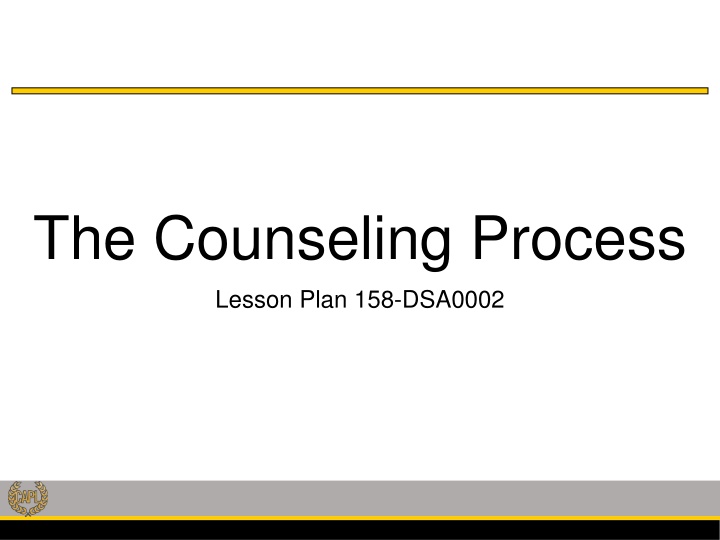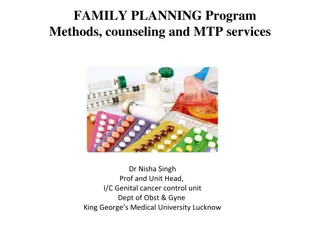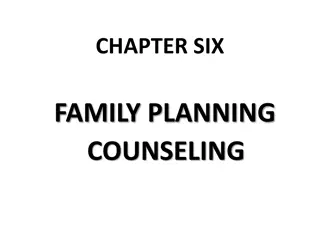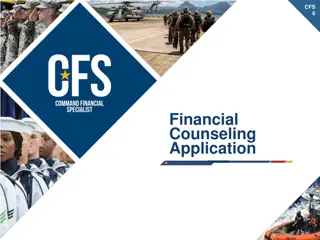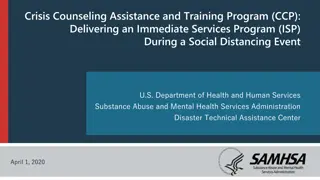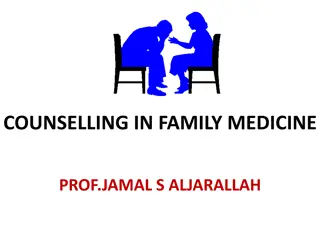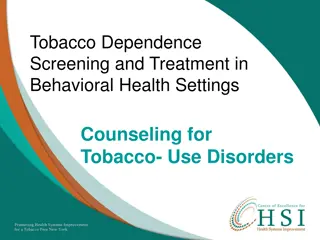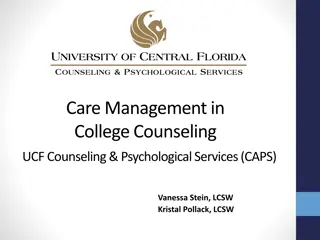The Counseling Process: Comprehensive Guide for Effective Counseling
Explore the intricacies of the counseling process in this detailed lesson plan, covering stages from identifying the need for counseling to conducting and following up. Learn about directive and nondirective approaches, preparing for counseling sessions, and practical strategies for enhancing communication with subordinates. Gain insights into ensuring effective counseling outcomes and honing your skills as a counselor.
Download Presentation

Please find below an Image/Link to download the presentation.
The content on the website is provided AS IS for your information and personal use only. It may not be sold, licensed, or shared on other websites without obtaining consent from the author.If you encounter any issues during the download, it is possible that the publisher has removed the file from their server.
You are allowed to download the files provided on this website for personal or commercial use, subject to the condition that they are used lawfully. All files are the property of their respective owners.
The content on the website is provided AS IS for your information and personal use only. It may not be sold, licensed, or shared on other websites without obtaining consent from the author.
E N D
Presentation Transcript
The Counseling Process Lesson Plan 158-DSA0002
Your Experience with Counseling What has been your best experience with counseling? What has been your worst experience with counseling? How do these experiences affect your ability to counsel junior Soldiers who really need it?
Terminal Learning Objective (TLO) Action: Conduct the counseling process. Conditions: As a candidate at the United States Army Drill Sergeant Academy, given experiential learning activities and access to references ADP 6-22, ATP 6-22.1, and AR 600-23, discussion with peers and instructor feedback, and reflection time. Standard: Apply all four stages of the counseling process in the correct sequence. Identify the three approaches to counseling. Complete all four parts of DA Form 4856 Developmental Counseling Form. Learning Domain: Cognitive Level of Learning: Application
Four Stages of Counseling Stage 4 Stage 3 Stage 2 Follow-up as needed. Conduct the counseling. Stage 1 Prepare for the counseling. Identify the need for counseling.
Stage 1: Identify the Need for Counseling. Required evaluation or command-directed counseling Counsel whenever focused, two-way communication aimed at the subordinate s development is needed
Stage 2: Prepare for the Counseling. Select a suitable place. Schedule the time. Notify the subordinate well in advance. Outline the counseling session components. Organize information and draft a plan of action. Plan the counseling strategy. Establish the right atmosphere.
Directive, Nondirective, and Combined Approaches Counseling techniques that leaders may explore with nondirective or combined approaches include: Suggesting alternatives Recommending Persuading Advising Techniques to use during the directive approach include: Corrective training Commanding
Stage 3: Conduct the Counseling. Open the session. Discuss the issues. Develop a plan of action. Record and close the session.
Parts of DA Form 4856 Part I Administrative Data Part II Background Information Part III Summary of the Counseling and Plan of Action Part IV Assessment of Plan of Action
Stage 4: Follow-up as Needed. Support subordinate in implementing the plan. Provide additional time, referrals, and other appropriate resources if needed. Continue to teach, coach, and mentor. Modify the initial plan of action, if needed, to meet its goals. Assess the plan of action.
Practical Exercise (PE) What are the Top 5 reasons trainees receive a DA Form 4856 counseling during Basic Combat Training (BCT)? Of the Top 5, each group will select one topic. As a group, you will develop a counseling using DA Form 4856. Be prepared to explain your actions as a counselor during all four stages of the counseling process. Share your counseling form with the class.
Summary The four-stage counseling process: Stage 1 - Identify the need for counseling Stage 2 - Prepare for counseling Stage 3 - Conduct counseling Stage 4 - Follow-up
